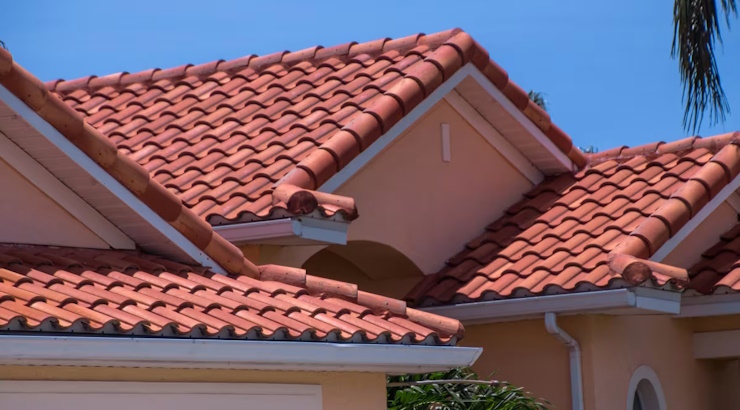Residential Projects
Clay Tile Roofing Materials
The pros, cons, and types of clay tile roofing materials.

Clay tile roofing dates back to the 1650s, when it emerged in the United States.
Known for its characteristic reddish-orange colour, clay tile is made from earthen clays moulded into rolled or interlocking shapes and fired for hardness.
It is often left unglazed, but it can be glazed with fluxes, earth minerals, manganese, silica, or aluminium oxide to increase durability and aesthetics.
With a lifespan exceeding 100 years, clay tile roofing materials stand as a popular choice among homeowners worldwide.
Types of clay tile roofs
Stemming from clay’s ability to take on any shape, tiles are versatile, suiting any architectural style from colonial to contemporary.
Clay tiles can be flat or round, with varying colours and profiles.
The natural materials soften with age, and traditional clay roof tiles comprise a two-piece style of a pan and a cover. Today, lower-cost, one-piece varieties are available with varying profiles including flat to mimic traditional shingles, slate, or wood shakes.
There are four main patterns of clay tile roofing materials.
1. Mission tile
Mission tiles, also known as barrel roofs, create a wave pattern by alternating concave pans, or dips, with convex covers.
The convex covers take the shape of half-moon-shaped barrels, while the concave pan tiles either mirror this curve or remain flat.
Prevalent in southwestern U.S., Spain, Italy, and France, mission tiles are installed in pairs with the cover overlapping the pan to provide a high-profile appearance.
Mission tiles have a polished look with a unique texture that changes in response to the shifting sunlight. However, they are expensive and labour-intensive to install.
2. Spanish tile
Spanish tiles made their debut in the U.S. through Florida, introducing a one-piece, S-shaped design that provides a visual appeal like that of mission tiles.
Nonetheless, they are less labour-intensive and cheaper to install.
Spanish tiles form a signature rippled roof effect without variations, offering a less customizable option compared to mission tiles – thus making it impossible to create distinct staggered patterns.
RELATED: How to Choose the Best Roofing for Your Home
3. French tile
Pioneered in the 1890s by Ludowici, French tiles stand out as a low-profile option among clay tile roofing materials. These tiles feature two distinct protruding flutes per tile, contributing to a textured aesthetic and enhanced drainage capabilities.
Additionally, these tiles incorporate a secure interlocking tab design that makes them particularly suitable for regions prone to hurricanes.
4. Flat tile
Flat tiles are designed to offer the durability of terracotta clay while imitating other popular roofing materials such as slate tiles and wood shakes.
These tiles can be installed to create multidimensional patterns, either through an interlocking design using fasteners or by laying them in a double thickness, reminiscent of traditional shingles.
Cost of clay tile roofing
Clay tile stands out as a premium and luxurious roofing material, ranking among the most expensive options available in the market.
The average cost of clay tiles ranges from $10 to $15 per square foot, with more uncommon ceramic tiles potentially reaching as high as $30 per square foot.
| Style | Average installation cost /sq. foot |
| Mission tile | $10 to $15 |
| Spanish tile | $8 to $10 |
| French tile | $9 to $11 |
| Flat tile | $3 to $9 |
Advantages of clay tile roofing
Durability: They can withstand threats such as fire, wind, sun, snow, and hail.
Longevity: They can last 100+ years with proper installation and maintenance.
Insulation: They keep homes cool during summer and warm during winter.
Disadvantages of clay tile roofing
Cost: They can cost three to four times more than asphalt shingles.
Weight: They are heavy; which necessitates a thorough assessment and possible reinforcement of the roof’s structure before installing a clay roof.
Delicate: Although tile roofs exhibit resistance to high winds, fire, and hail, individual tiles are fragile and prone to breakage during the installation process.
RELATED: How to Install Metal Roofing for Your Home
Maintenance of clay tile roofs
Proper maintenance is essential for maximizing the lifespan of your clay tile roof.
Schedule an annual inspection by a roofing professional to check for issues such as moss growth, mildew, cracked tiles, and other signs of trouble, especially along the roof’s edges where tiles are more exposed.
If you discover broken tiles, it is important to remove them carefully to avoid damaging surrounding tiles while maintaining the overlapping pattern. Keeping extra tiles from the initial installation ensures a seamless match for replacements.
Regular cleaning is also important considering that dust, organic matter, and debris can accumulate, fostering the growth of algae, moss, and mildew.












